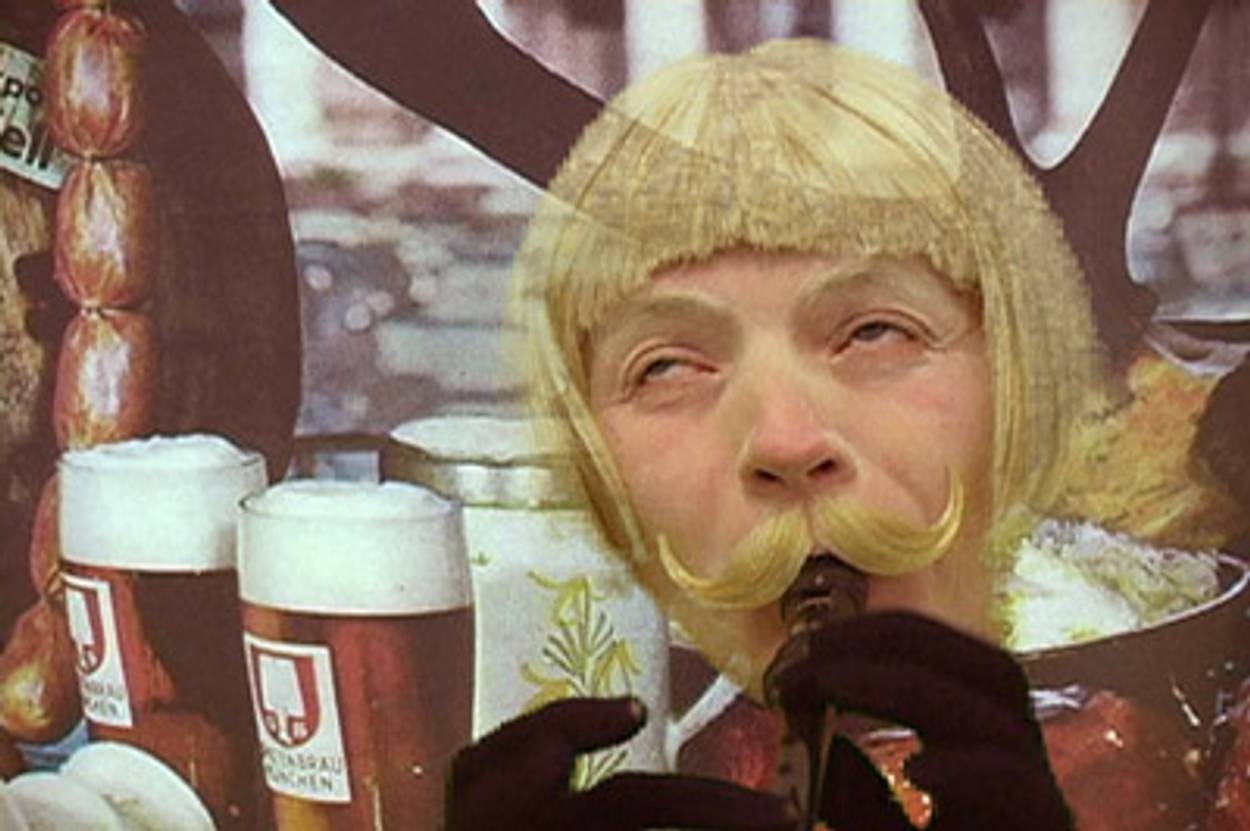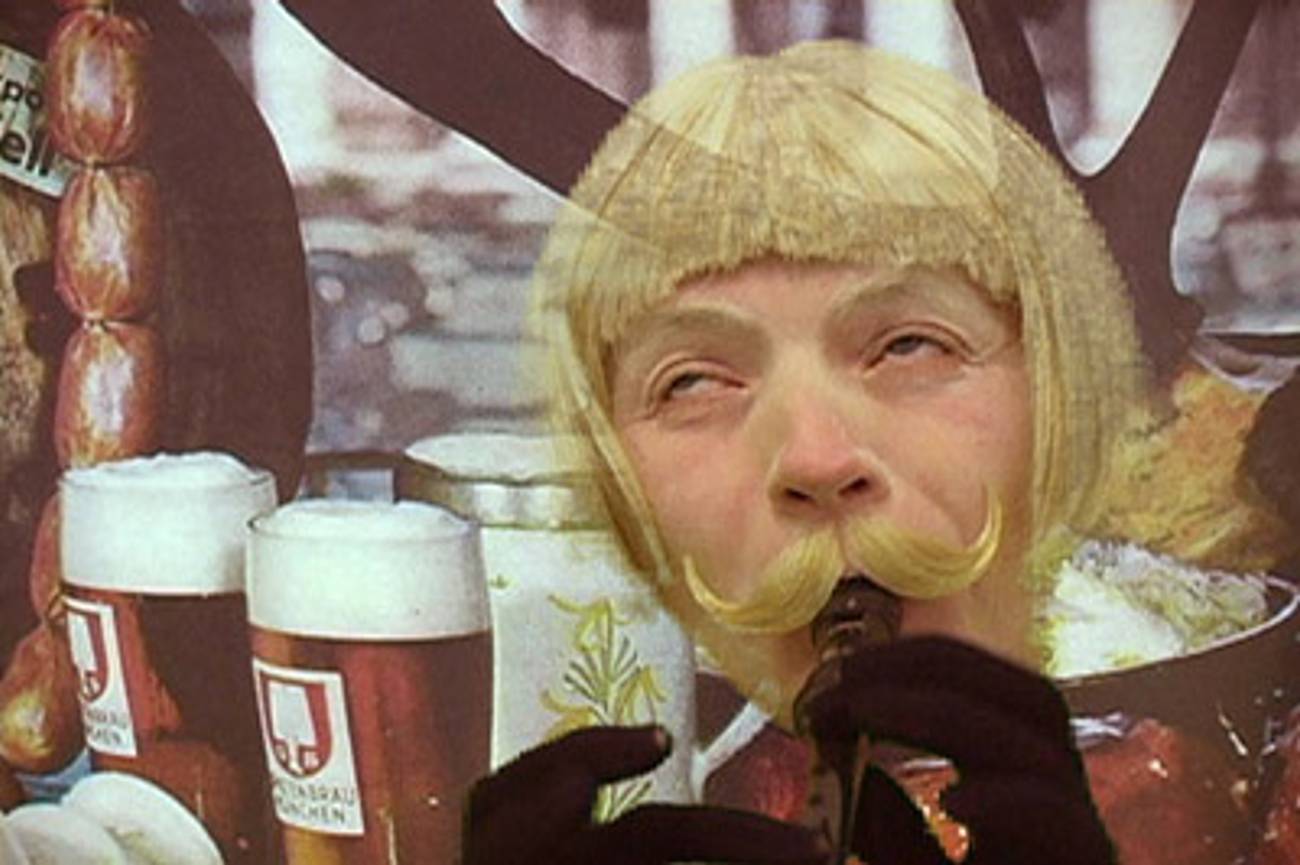Not a Pretty Sight
The transformative art of Tamy Ben-Tor




The four-minute video playing on a small television set at the back of New York’s Zach Feuer Gallery opens with a simple, black title screen—Baby Eichmann, a reference to Adolf Eichmann, the “architect of the Holocaust.” It fades into a photo of a summertime landscape with evergreens and jagged peaks against blue skies. The face of a mustachioed towhead appears, superimposed over the scenery, gaily playing a wooden pipe. A female narrator begins recounting, in German, an all-too-familiar tale. “We didn’t know the man with the moustach [sic] was evil,” read the English subtitles. Then the story takes an odd turn: “We were drunk. We are still drunk. We will always be drunk. Why not? Live a little.” The video cuts to a brunette woman in a high-necked blouse sitting on a couch, looking like an interviewee from so many Holocaust documentaries. “We all saw, but what could we do?” she asks, in English, with a heavy German accent. A stream of words scrolling across the screen offers an answer: “When it comes down to it, what everybody cares about is themselves and not the rest. It’s a sort of pornography that people embrase [sic] the disasters of others. It makes them feel good.”
Both the pipe-player and the interviewee are Tamy Ben-Tor. They’re two of the many bizarre characters—amalgams of personalities she encounters on the street and in her imagination—the Israel-born, New York–based performance and video artist has created to engage the issues that interest her: assimilation, xenophobia, the Holocaust, and Arab-Israeli relations. Through changes in costume, language, and mannerisms (along with wigs and false teeth and the occasional goofy pair of glasses), she transforms herself into a Nazi youth, a ditzy blond American, or a European intellectual. Her depictions are usually grotesque, and often hilarious. What at first may seem like stereotypes quickly become much more complicated, confusing, and weird.
Ben-Tor has called her practice “an exploration in the domain of idiocy,” a phrase that also served as the title of her first solo show, of five videos and a performance, at Zach Feuer Gallery in 2005. Her second solo exhibition, featuring four videos, is on view there through May 2. To coincide with the show’s opening, in late March, she reprised her live work-in-progress Judensau at The Kitchen. When she first performed it, in 2007, at New York’s performance-art biennial, PERFORMA, New York Times critic Holland Cotter described the piece as a “scathing, self-lacerating meditation on stereotypes of Jewishness, seen from inside and out,” and went on to call Ben-Tor “phenomenal, a star.”
Cotter is only one in a chorus of voices singing Ben-Tor’s praises. In 2005, her video Women Talk About Adolf Hitler (2004) was the talk of P.S.1 Contemporary Art Center’s “Greater New York” exhibition, featuring 162 emerging artists. In the Village Voice, critic Jerry Saltz used the word “startling” to describe the work, in which four female characters (all played by Ben-Tor) discuss the Führer;
among them is a gender-studies writer who points out that, in addition to being a maniacal dictator, he had a bad digestive system and knobbly knees. A December 2005 blurb in The New Yorker, announcing Ben-Tor’s first show at Zach Feuer, called Women Talk About Adolf Hitler “a hilarious string of performances that ultimately diminish Hitler’s stature” and compared Ben-Tor’s acting abilities to Meryl Streep’s. At the same time, Slate named her “Artist of the Month,” and in September 2007, ARTnews listed her among its “25 Trendsetters.” Ben-Tor turned down Nextbook’s request for an interview because, as a Zach Feuer representative explained, a “major American monthly magazine” is running a profile of her in June.
The thirty-two-year-old has come a long way from her childhood in Jerusalem, spent watching American TV shows. She says they were a major influence on her work. “If you look at television in the ’70s, it’s more about the characters: The Brady Bunch, Days of Our Lives, Happy Days,” she told The Jerusalem Post in 2001. “There were six kids on The Brady Bunch and each had their own personality.” After fulfilling her Israeli army service requirement, she embarked on a three-year course at the avant-garde School of Visual Theater in Jerusalem, founded in 1986 by a group of puppeteers. There she created The Tamy Ben-Tor Show, in which she portrayed three American characters described by the Post as “Mrs. Boone, the doll-faced advocate of Christian conservatism; Harriet, who has recently been kicked out of the Woody Allen Fan Club; and Lenny, the naïve girl-next-door who thinks she looks like Shirley Temple.” Elements of Ben-Tor’s current practice were evident even then, namely exaggerated-bordering-on-absurd characters and her morphing from one to another onstage. She performed The Tamy Ben-Tor Show at clubs and theaters in London, New York, Tel Aviv, and Jerusalem, later adding to her repertoire Electroyiddish, a cabaret-style performance of Jewish folk songs set to electronic beats.
These acts were well received by their mostly young viewers, but Ben-Tor ultimately found them unfulfilling. In 2004 she moved to New York to study in the visual arts department at Columbia University, where she received her MFA in 2006.
“I felt that I needed the audience to go deeper into what I was doing,” she told PERFORMA founder RoseLee Goldberg in an interview published in the PERFORMA 05 book. “I knew that if I performed in the art world, I had to think about my motives more intellectually, and that appealed to me.” Superficially, her work resembles one-woman sketch-comedy shows, like those of Tracey Ullman, but her vignettes are not narrative. “You can get away with storytelling in the mainstream,” says Goldberg, “but not in the art world. Nobody would sit through Tamy just telling personal tales.”
Ben-Tor seems to have found the audience she was looking for. Capacity crowds came to watch her perform Judensau at The Kitchen. In the span of about thirty minutes, she inhabited five very different characters. By kneeling and tucking her arms into the sleeves of a black button-down shirt with “Zoo York” embroidered on the pocket, she became an abrasive Orthodox dwarf. “I want to live among the gentiles,” the dwarf said. “I want to eat a bacon cheeseburger with a big pork chop and a glass of milk.” She shifted into a hip-hop Jewish grandma who shows her pride in assimilation by wearing a Jesus T-shirt. “I read about what the Jews are doing in Palestine. If they’re not careful, they’re gonna bring another Holocaust on themselves,” she said. “The only thing left of the Jews are gonna be little pieces of challah.”
At that, uneasy chuckles rippled through the audience. This shared discomfort—is it okay to laugh?—is “part of the content of the work,” says Gregory Amenoff, chair of Columbia University’s visual arts department. “All performances should be reflected back to the viewer, but her work is particularly that way.”
Judensau is an anti-Semitic slur meaning “female Jewish pig,” and one can’t help wondering if Ben-Tor is referring to herself. “It’s not such a stretch to be a bastard,” she has said of her unlikeable characters. One such personality in the performance is an ogress with rotting teeth, ratty black hair, a long goatee, and a unibrow. “What does a Jew look like?” she begins, before launching into a diatribe in German, spitting out words like “schweine,” “Jude,” “Holocaust,” and “Yad Vashem,” and literally gagging over the word “America.”
Ben-Tor’s intention in portraying such personas is to “disarm anger” rather than to incite it, she told Goldberg about her 2005 performance Exotica, the Rat, and the Liberal—but she doesn’t always succeed. That piece, also for PERFORMA, ended with Ben-Tor, as a Long Island–accented woman, telling a joke about two Jews in a ghetto. “I see from your gold star you’re a Jew,” says one. The other replies, “No, I’m the sheriff.” Saltz gave the work a glowing review in the Village Voice (“It’s a Kabuki play from hell by way of the shock comic Sarah Silverman”), but noted that some audience members were “totally insulted.” “The ‘insult’ in Ben-Tor’s work stems from the fact that this artist doesn’t approach the Holocaust as a one-dimensional closed case,” he writes. “The Holocaust is alive in Ben-Tor’s raw, awkward, cutting work. It isn’t confined to a set of academic gestures or hackneyed responses.”
Those who take offense can’t claim that Ben-Tor isn’t an equal-opportunity offender. She pokes fun at Jews and Nazis, Israelis and Arabs. “I invented mutations that don’t represent any ‘side,’” she told Heeb magazine in 2003. In Baby Eichmann, for example, she ridicules Germans for their complicity in the Holocaust,
but in the nearly nine-minute video Gewald (2007), also on view at Zach Feuer, she plays (among other odd characters) a headscarf-wearing woman who likens the Jews not wanting to leave Europe to ancient Jews not wanting to leave Egypt.
Saltz, in his Voice review, quoted one viewer who asked, “Can’t we all just get over the Holocaust?” Ben-Tor agrees that “Nazism has been made into a fetish,” and told Goldberg she has “outgrown that way of looking at it.” In a 2007 interview with the artist Jon Kessler (a professor of hers at Columbia) on P.S.1.’s Internet radio station, she explained, “I’m fascinated by the relationship of the powerful and the weak, the detested and the admired, whoever that is.” She continued, “The Holocaust is not for Jews, about Jews. It’s a humanity thing.”
Ben-Tor described her characters to Kessler as people she either despises or wishes that she could be. Many speak languages like Yiddish, German, or even German with an Arab accent, making them impossible to understand for many American viewers. This contributes to the work’s “nonsensical outcome,” Ben-Tor wrote in a statement for her current show. She has used such words as “chaos” and “collage” to describe her methods, and she has said in several interviews that she is not interested in politics and that her work is not journalism. “Her pieces are not preachy,” says Amenoff. “She’s not reassuring what you already know—that’s the problem with very didactic political art.” So is there a point? Maybe. As Ben-Tor told Heeb, it’s “comic relief.”